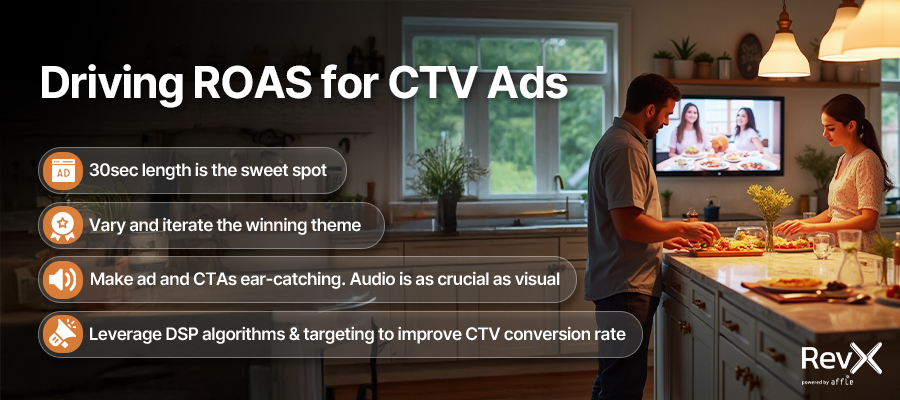Advertising on big screens. Hitting scale with household-level targeting. Reaching highly engaged viewers, including opportunities for brand recall, with sound-on unskippable ads–it might all sound too good to be true! However, there are real advantages and performance-based qualities of Connected TV (CTV), and they are indeed multiple.
You’re probably here because you want a shot at its incredible potential too. With growing competition and potential data overload, how can you use CTV ads to their ultimate capacity, take advantage of unique targeting opportunities, and convert when and where it matters?
To solve the CTV puzzle, you have to treat your campaigns like the Sorcerer’s Stone, turning users’ attention into precious gems. You may find you need to refine your audience segments, retarget high-intent viewers, or leverage interactive ads to raise engagement, but every move should be calculated and impactful.
You already know the importance of CTV advertising, the different CTV ad formats available for your campaigns, and how you can create and launch powerful CTV ads that reel viewers in. We’ve gone beyond the basics, and now it’s time to get into the nitty-gritty tactics that will make your ads leave a lasting impression.
In this fourth installment of our series, we’ll lay out the best CTV ad strategies that have been tested, optimized, and proven to get you return on ad spend (ROAS). You’ll learn how to craft data-driven campaigns, use insights to tweak performance, and turn passive popcorn-munching viewers into app installers and burgeoning brand ambassadors.

How can I prepare for a successful CTV campaign?
👥👩🏽💻 Use first-party data
Data is the most essential thing in CTV, and luckily there is plenty of it to tap into. This channel is rooted in user data. Combined with your brand’s first-party data to guide you, you can turn this powerful user information into Oscar-winning performances, by making ads that work for a variety of audiences and segments, outshining others when used correctly.
Unlike third-party data, which is often outdated or available to everyone, first-party data belongs only to you. It’s the insights you gather directly from your audience through your website, app, or CRM. You get to know their age, location, buying behavior, and preferences. These details tell you exactly who your customers are, what they want, and when they’re ready to take action while keeping your costs down.
With this data, you can identify the kinds of people watching your ads and tailor your campaigns to fulfill their interests. It can serve your CTV ads to high-intent users like cart abandoners or prolific app installers. You can even create hyper-targeted segments and build lookalike audiences to expand your reach. Performing tasks like matching your CRM lists, website visitors, or app users with CTV identifiers ensures consistent user identification while respecting privacy. When you launch your campaigns, you can whitelist loyal customers, exclude existing buyers from acquisition ads, and use real-time metrics to adjust the ad’s performance for the effective delivery of personalized content. While your competitors are still relying on generic targeting methods, you’re refining your segmentation so your ads are always on par with your audience, and even accessible across devices.
📲🌎Set up geotargeting
If you’re running a campaign for a product launch in the metro region of Austin, Texas, do you really want someone in Austin, Colorado to see it? Definitely not! It’s counterintuitive to let your ads run amok in places where they’re not meant to be, and the precision of CTV allows you to evade these mix-ups.
Geotargeting is your authorized gatekeeper here. It delivers relevant ads straight to viewers based on their exact whereabouts, you can even target by latitude and longitude. It allows streaming platforms to track household IP addresses, subscriber zip codes, and device locations, if enabled. When an ad break hits, the system matches viewer location data with your targeting filters, positioning away from residual wasted budgets.
If you want to implement geotargeting, think about the granularity you’ll need for your campaign: state/city-level targeting, radius and zip codes, or hyper-local campaigns. Layer it with demographics and behavioral data, and you have a laser-targeted approach locked in.
Once everything is ready, track regional performance, shift ad spend to high-performing areas, and retarget viewers on mobile to drive action. This layer encourages pertinent downloads, language-specific subscriptions, and regional online sales.
▶️🎯Enable retargeting
Capturing viewers’ attention is good, but keeping it is where the real ROI happens. A person may see your ad flash on their TV screen, or hear your jingle from the kitchen island nearby, yet it may take a couple more views/listens before they decide to take action. To ensure that your ads show up for people who have encountered your brand previously, you should let CTV retargeting pull up your campaigns more frequently and tap into this primed user base.
Retargeting lets you re-engage audiences who’ve interacted with your brand, whether they’ve signed up for services, visited your website, or browsed your products. Contrary to traditional televisions, CTV uses deterministic matching, which pulls IP addresses and device IDs to track viewers across screens and distribute personalized follow-up ads for conversions. Whenever a user sees your ad on Roku, Tubi, or another streaming platform, a tracking pixel or identity graph captures their interaction. The next time they’re scrolling on mobile or watching TV, they get a well-timed reminder. Maybe it’s another ad, a sequential message, a limited-time offer, or a cart abandonment nudge–campaign messages are decided by you, the marketer, after all–but everything is made to move them from interest to action.
To make the most of it, refine audience segments, optimize ad formats depending on the goal (video length, creative trends), and monitor key metrics like view-through rates (VTR) and cost per acquisition (CPA), being mindful of the opposite occurrence taking place through ad fatigue. The more chances you get to gain their trust and succeed at this, the closer to conversions you’ll get.
⏳🖼️Create short, visually engaging ads with clear CTAs
Following user behavior and cultural cues, ads have progressively gotten shorter, especially in digital advertising. Longer ads traditionally cost more to produce and air on linear TV, thus advertisers picked shorter formats to stick to their budgets. However, it’s more because people have limited patience and endurance for content that doesn’t pique their attention.
CTV ads live and die by clarity and impact. You’ve got only a few seconds to convince your audience before they skip and zone out from your content!
Thirty-second ads strike the perfect balance, outperforming other lengths by 24% in conversions. For brand awareness, 15 seconds work, but if you want deeper storytelling, you might want to consider sixty. Whatever the duration, the first six seconds are make-or-break. Before you bore your viewers, use bold visuals, striking audio, or a provocative question to keep them watching.
Of course, ad length isn’t the only thing to consider. Aside from running short ads, you must also make them attractive and memorable. Pair vibrant visuals with persistent branding. Your logo should stay on-screen, and text overlays must be minimal yet clear. Make your calls to action (CTAs) explicit and reinforced. You can even use both on-screen text and voice-over cues to emphasize your point. For a more detailed guide on how to create winning CTV ads, you can view our previous article.
Pro-tip: You may also want to consider aligning your ads with other channels as well to increase response rates, mirroring messaging across social media and search ads. Keep the frequency between 6–10 impressions per viewer to stay top of mind without causing ad fatigue. Marketing mixed modeling (MMM) could serve your forecasting efforts to help predict the right blend of budget investment per channel.
🎨⚙️Apply Dynamic Creative Optimization (DCO).
Non-dynamic ads are relics of the past. If you find that you are sitting on outdated creatives, i.e. ads that have been eroded through time, then you can recreate them using Dynamic Creative Optimization (DCO).
With DCO, you amp your performance marketing power, developing personalized, data-driven CTV ads that adapt in real time, allowing for various versions of an advertisement to be tailored to a single user.
Whether it’s location-based promos, weather-targeting messaging, or live sports score updates, DCO switches creative elements like imagery, messaging, and CTAs based on user data, contextual triggers, and performance metrics. The advertisement automatically adjusts to accommodate its viewers. It’s a win-win for advertisers, like turning the TV on and bringing drinks to the couch with one remote.
If you want DCO for your CTV campaigns, start with modular creative assets. You can design base videos with dynamic overlays for text, offers, or region-specific visuals. A demand side platform (DSP) such as RevX delivers them to your target audiences.
You can also use machine learning to prioritize top-performing variations and improve triggers for continuous performance gains. When you have DCO, you increase personalization, lower ad fatigue, and become known to viewers to show unique content they resonate with.
🏖️⛷️Focus on contextual targeting
Personal, first-party data may not be all you need when you’re optimizing your CTV ads. If you want your campaigns to reach the right audience by aligning with what they’re watching, not solely who they are or where they are located, then contextual targeting is your golden ticket.
A protein shake appearing alongside workout tutorials? A travel campaign running during an adventure film? You want to reach viewers who are likely prequalified for your own offer.
Using contextual targeting, you can use streaming metadata, genre classifications, and AI-driven content analyses to position ads in relevant environments that will give you the most engagement and impact.
To execute this, connect with streaming platforms or DSPs with contextual targeting capabilities. Define your triggers, such as genres, moods, and themes, as these will match your brand’s message with the right content. Dynamic Ad Insertion (DAI) will place your ads among related shows where they can complement the viewing experience. This way, your CTV campaigns will only reveal themselves to an invested audience.
🕹️🚀Craft and launch interactive ads
Your CTV campaign can be more than just a blend of images or a compelling video. If you have the skills or resources to create CTV ads that captivate and encourage your audience to join in, try this engaging format for memorable ad-play and brand recall.
These ads can come in the form of QR codes for instant discounts, clickable overlays for product browsing, or gamified experiences. With an average engagement rate of 5.42% versus 0.97% for mobile and PC, they perform better than traditional formats, making them a must-have for advertisers looking to acquire measurable results. However, they can be expensive with CPMs (costs per mille) reaching 15% higher due to complex creative production.
If you do have the capacity to run them, tweak your ad format and interactivity to your goals.
- QR codes work best for direct conversions, but they must be large, scannable, and on-screen for at least 5 seconds.
- Keep three or fewer interactive elements to prevent confusion, and consider enabling voice commands to allow action when your viewer is away from their remote control.
- Most importantly, make your design clean and intuitive with instructions properly stated, so your audience knows what they should do.
📐🔀Implement cross-device attribution
CTV ads do more than just influence viewers. They also motivate action across devices.
If you want to keep an eye on the impact of your ads beyond the big screen, cross-device attribution should be part of your campaign repertoire. It can capture a mobile app install, a website visit, or even an in-store purchase. By linking devices through IP-based matching, household graphs, and SDK tracking, you can use it to measure how CTV exposure contributes to your conversions.
When you want to make this attribution work, look into a strong tracking infrastructure first. You can try Mobile Measurement Partners (MMPs) like AppsFlyer or Singular, which can monitor when someone sees your CTV ad and later takes action on another device.
To make this tracking more effective, add cross-device links to your CTV campaigns so you can follow users as they move between activities and consoles, PCs, and smart devices.
Pro-tip: In your attribution model, give CTV ad impressions priority and use household-level data to connect CTV ad exposure to offline actions like a store visit or an in-person purchase. You can then review cross-channel reports to see which ads are generating results.
🏋️📺Push for Dynamic Ad Insertion (DAI)
Like the dynamic, personalized rendering of DCO ads, Dynamic Ad Insertion has risen in popularity due to its highly relevant capabilities. It’s become part of the digital marketer’s lexicon, most recently through the medium of podcasts, although CTV is a potent discovery place for it as well.
If you want your CTV ads to be shown to the right audience at the right time, Dynamic Ad Insertion is a clever server-side ad-insertion technology that allows a seamless, tailored ad experience at scale. By requesting video ads and unifying them into an ad pod, commercial break, or live-event pause, DAI can offer timely delivery of ads optimized for the context of the viewer. Within the same video content, various ad varieties could be shared.
Imagine a live football game is streaming on various platforms. It’s halftime, and the game is tied. Your advertisement emboldens local viewers to download your music app and play the team’s hymn to cheer on their favorite players from their homes. Not only will you capture impactful first-party data on response time, installs, track plays, playlist saves, social shares, etc., you could insert DAI into the next ad break to remind viewers to check the app for the “winning” team according to number of listens.
Traditional ad delivery methods load separately and can cause lag. Meanwhile, DAI stitches ads into the video stream itself. It lets you place personalized ads directly into live and on-demand content for a buffer-free, uninterrupted viewing experience. This keeps viewers close to their original content and increases brand trust associated with high-quality ads. It’s also a powerful way for advertisers to measure post-campaign events connected to ad exposure.
You need the right tech stack before you can use DAI for smooth integration and ad block prevention.
Pro-tip: Use VAST-compliant creatives as they’re the industry standard for video ads, but avoid VPAID ads, since they aren’t compatible with CTV transcoding, and most platforms block or ignore them. Test your campaigns across direct sales and programmatic demand with tools like DAI Prefetch to eliminate delays. For multi-device compatibility, incorporate Interactive Media Ads (IMA) SDKs or Dynamic Ad Insertion (DAI) APIs to manage ad placements.
In Summary
CTV advertising, as with any powerful tool, is only as effective as how well you wield it. The strategies we’ve mentioned here can help your CTV ads get more traction and revenue, but we also suggest careful tracking and monitoring. A checklist can help organize, yet the best CTV strategies require constant refinement.
Those who thrive in the Connected TV (CTV) space analyze performance, adjust creatives, and continuously adapt their approach to match what their audience wants and expects, as well as what’s trending in the environment. Whether it’s through interactive ads that encourage participation, contextual targeting that prioritizes relevance for seasonal events, or cross-device attribution that tracks the bigger picture, the brands that anticipate and embrace change can fully reap the benefits of this emerging, precision channel.
As audience behaviors shift and technology advances, so too must your approach. Stay informed, partner with trusted inventory sources, and seek ways to make your ads more targeted and compelling. If you’re looking for a partner to establish and guide you through the CTV landscape and re-engages users right alongside, you can contact our team.
Look at your CTV ads as long-term investments rather than one-time experiments. ROAS in the end isn’t a fleeting experience, it should be the desired course and revered KPI, and is within reach with the right strategies added to your campaign’s proverbial remote control.



